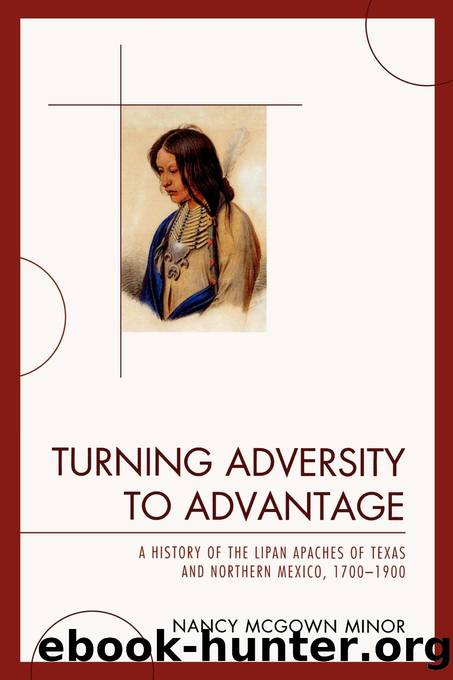Turning Adversity to Advantage by Minor Nancy McGown;

Author:Minor, Nancy McGown;
Language: eng
Format: epub
Publisher: UPA
Published: 2009-08-15T00:00:00+00:00
Chapter 11
Juan de Ugaldeâs War against the Apaches of Coahuila, 1779-1790
âMaking war with perfidious treacheryâ1
After 1770, the Lipans in Texas and the Lipans in Coahuila faced two very different sets of problems. By 1780, the Texas Lipans were weakened by a half century of Comanche aggression, Spanish intrigue and sporadic attacks by other Texas tribes. Their main focus was the dismantling of the Spanish-Comanche alliance and the continuation of the horses-for-guns trade. The situation was very different in Coahuila. In Texas, the Lipans used political manipulation to break a Spanish alliance with the Comanches, but in Coahuila, the Lipans turned to warfare to preserve their alliance with the Mescaleros.
From the time of the Lipan entry in 1751, the poor settlers of Coahuila had not known more than three years of peace (1776-1779). With a total area half the size of Arizona and with a climate and terrain similar to west Texas, the Province contained only 5,043 non-Indian inhabitants in 1770, a population insufficient to defend Coahuila from incessant Lipan and Mescalero raids (Gerhard, 1920; 332). The constant menace of Apache attack had profound consequences. The arable farmland was never fully developed, settlements remained small and isolated, and the population remained sparse. The raw reality of life on the Apache frontier had become so terrifying after 1765 that many settlers in the Santa Rosa Valley attempted to flee to the neighboring Province of Nuevo Leon. The Coahuilan Governor ordered all settlers to forego the eating of meat because so many cattle, sheep and horses had been stolen (Cabello, 1784: 117-119). The cost of maintaining the presidios and soldiers necessary to protect the populace drained the Royal Treasury. While there was some mining and a number of large haciendas producing and marketing cattle and some food crops, the Province as a whole produced little wealth or resources capable of offsetting the large military investment. A contrasting situation existed in the neighboring Province of Nuevo Leon. There, large mining operations and rich farmlands produced great wealth, aided no doubt by the fact that the Province was spared wide-scale Apache depredations until after 1780, thus lessening the cost of military investment necessary to protect the populace. Neighboring provinces to the west, Nueva Vizcaya and Sonora, produced enough mineral wealth to offset the cost of Apache attacks. Only poor Coahuila, the playground of Lipan and Mescalero raiders, remained undeveloped and impoverished, its settlers and livestock killed or carried away every spring and summer as Apache raiders returned year after year for their annual âharvest.â
The Lipan and Mescalero raiders of Coahuila were generally unrestrained by fears of Comanche aggression into the interior of Coahuila. Comanche war parties only occasionally crossed the Rio Grande in hot pursuit of Lipans and when they did, the Spanish cavalry from the Rio Grande presidios was sufficient to chase the Comanches back across the river into Texas. Yet, the Lipans and Mescaleros had penetrated deep into Coahuila, almost as far as Saltillo, by 1782. This feat was not duplicated by the Comanches until 1840-1841 (Kavanagh, 1996: 208).
Download
This site does not store any files on its server. We only index and link to content provided by other sites. Please contact the content providers to delete copyright contents if any and email us, we'll remove relevant links or contents immediately.
Chaco's Northern Prodigies : Salmon, Aztec, and the Ascendancy of the Middle San Juan Region after AD 1100 by Paul F. Reed(338)
Law Enforcement Interpersonal Communication and Conflict Management by Brian Douglas Fitch(331)
Digital International Relations by Unknown(324)
Critical Perspectives on Human Security : Rethinking Emancipation and Power in International Relations by David Chandler; Nik Hynek(315)
The Enduring Color Line in U.S. Athletics by Krystal Beamon Chris M. Messer(309)
Skilled interpersonal communication: Research, theory and practice, Fifth edition by Owen Hargie(309)
Evidence-Based Policy Making in Labor Economics by Hamermesh Daniel S.;Nottmeyer Olga K.;Nottmeyer Olga;King Sarah;King Sarah;King Sarah;(277)
EPSO CAST Political affairs EU policies: How to succeed in the selection procedure by Franco Reverte José María(272)
Writing Public Policy - A Practical Guide to Communicating in the Policy Making Process by Catherine F. Smith(256)
Threshold Concepts in Women's and Gender Studies by Christie Launius Holly Hassel(249)
Criminological Theory in Context by John Martyn Chamberlain(249)
Tibeton Yoga Its Secret Doc by Evans-Wentz(245)
Positive Psychology and Spirituality in Counselling and Psychotherapy (Conflict, Ethics, and Spirituality, 12) by unknow(245)
Rothschild and Early Jewish Colonization in Palestine (Geographical Perspectives on the Human Past) by Ran Aaronsohn(244)
Social Problems, Social Issues, Social Science by James Wright(243)
Play in child development and psychotherapy: toward empirically supported practice by Sandra W. Russ(239)
Cognitive Development in Infancy and Childhood (Elements in Child Development) by Mary Gauvain(235)
Latin American Politics and Society by Gerardo L. Munck & Juan Pablo Luna(208)
What Makes a Social Crisis?: The Societalization of Social Problems by Jeffrey C. Alexander(206)
